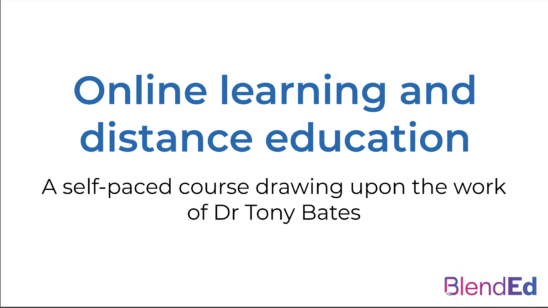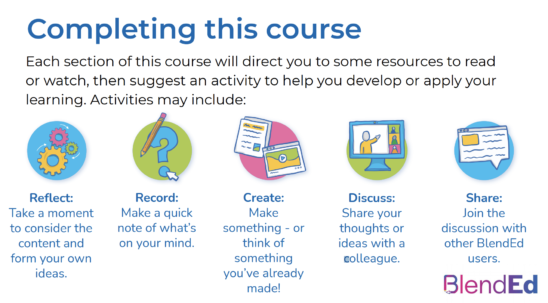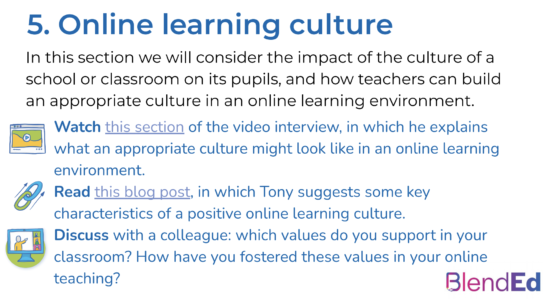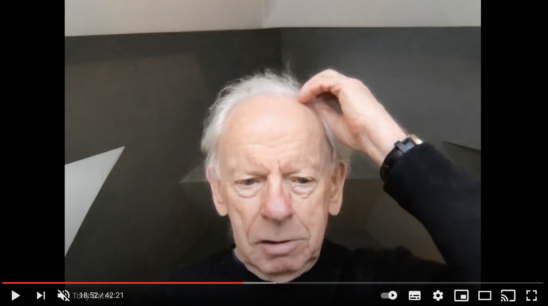
Who created the course?
BlendEd is a teacher-organised program that offers free professional development and resources for teachers to support blended learning pedagogy. Based in London, England. BlendEd is run by the London Connected Learning Centre.
Who designed the course?
The Connected Learning Centre has developed a free, self-paced online course designed for teachers who have gained some experience of online teaching and are hoping to put these skills to good use as the conditions of the teaching profession continue to change in the wake of the global pandemic.
The course combines suggested readings from blog posts I have written on school (k-12) education during the Covid-19 pandemic, with additional input from a 45 minute Zoom-recorded video interview between CLC director, Sarah Horrocks, and myself, recorded on February 9, 2021.
How do you take the course?
To complete it, teachers simply work through an 11 page PDF (2 MB), which links to textual and video resources as well as online spaces in which they can share their ideas with other learners. They can also watch the full interview on the CLC Youtube channel.
Each section of the course will direct the teacher to some resources to read or watch, then suggest an activity to help them develop or apply their learning. Activities include:
- reflection
- note-taking
- creation of a teaching activity
- discussion
- sharing

What’s in the course?
There are seven pages covering the following topics, each with an activity:
- What are the challenges posed when learning moves from in-person to online?
- Issues around curriculum and learning design when moving online
- The importance of teacher presence online
- The role of parents
- Developing an appropriate online culture/set of values
- Strengths and weaknesses of online learning in schools, compared to post-secondary education
- Advice for decision-makers (school administrators/policy-makers)

My comments
I suppose you could chalk this course up to the value of open educational resources. Apart from the 45 minute video, which has been chopped up to support each of the pages, and the time of the people at the Connected Learning Centre, all the material already existed in another format.
Second, this is a good example of ‘agile’ design. The course took less than a month to put together. Quick and (somewhat) dirty is essential during a pandemic, when teachers are desperate for help.
I must also say that the video is a classic of pandemic Zoom recording. I’m wearing scruffy clothes (not intentionally – I overslept and almost missed the recording appointment, because of the time difference between London and Vancouver), my hair’s a mess, I rub my nose and scratch my head, and I look the full 82 years I have lived so far. However, I am still pleased with the recording because it’s unscripted, I’m having to think on my feet, and I feel that I am talking directly to the viewer, even though I never at any point look straight at the camera (As usual with Zoom, I was looking at the screen window of the interviewer). So I broke all the rules I learned in my long-ago BBC television producers’ course.

However, in the end, teachers who are looking for help teaching online must be the ultimate judges. In the meantime, I am very grateful to Sarah Horrocks and the Connected Learning Centre for the opportunity to get my ideas across to a wider audience. If you do the self-paced course, let me know if it was helpful – or otherwise.









 Dr. Tony Bates is the author of eleven books in the field of online learning and distance education. He has provided consulting services specializing in training in the planning and management of online learning and distance education, working with over 40 organizations in 25 countries. Tony is a Research Associate with Contact North | Contact Nord, Ontario’s Distance Education & Training Network.
Dr. Tony Bates is the author of eleven books in the field of online learning and distance education. He has provided consulting services specializing in training in the planning and management of online learning and distance education, working with over 40 organizations in 25 countries. Tony is a Research Associate with Contact North | Contact Nord, Ontario’s Distance Education & Training Network.

